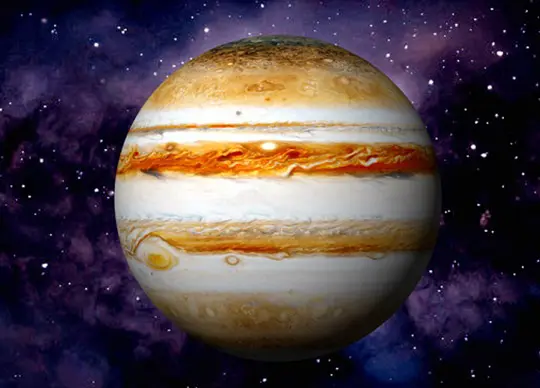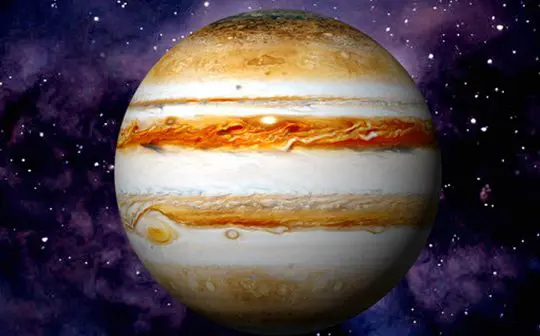
Written by Dr Eleanor Sansom, Planetary Scientist, Curtin University.
The European Space Agency’s Jupiter Icy Moons Explorer (Juice) launched on the 14th April 2023 on an eight-year voyage to our solar system’s largest giant gas planet – Jupiter. The Juice mission is embarking on an extraordinary journey to unravel some of the mysteries of Jupiter and its fascinating moons.
To reach Jupiter using as little power as possible, multiple gravity assist manoeuvres are performed. This uses the gravitational pull of other planets to get sucked in, and sling shot out the other side with a greater speed. Juice will perform several of these manoeuvres, including a solar system first: a binary gravity assist with both our Moon and Earth, arriving at Jupiter in 2031. It may take time, but it is extremely efficient.
This interplanetary spacecraft’s original proposal was selected as part of ESA’s Cosmic Vision program back in 2012. With 10+ years in the making, and another 8 years until it reaches its destination. The question arises: why the substantial effort?
Jupiter’s moons may hold the key to understanding life’s origins.
And we’re not just talking about life within our own solar system, but how life might form, evolve, thrive or die across our galaxy and possibly the universe.
As technology develops, the capacity for humans to explore our cosmic surroundings has gone far beyond our own solar system. We know of nearly 4,000 exoplanets orbiting other stars in our galaxy. Although the new James Webb Space Telescope has recently identified the first Earth-like planet around a foreign star, most exoplanets we know of are large, gas giants, similar to our own Jupiter.
And yet, as our curiosity and capabilities drive us deeper into space, the knowledge to understand it is in our own backyard (so to speak). There is still so much to explore and understand around our own Sun. Knowing that planet formation is a common process across the universe, studying our own solar system is crucial to understanding what might be possible, or even a given, around other stars.
Jupiter itself is analogous to many discovered exoplanets, and it possesses nearly 100 known moons. The four largest, known as the Galilean moons, likely formed alongside Jupiter nearly 4.5 billion years ago in the early solar system. Some of these moons are believed to have had or still possess conditions favourable for life, making them extremely interesting subjects for study.
Only two previous missions, NASA’s Galileo (1995-2000) and the ongoing Juno mission, have spent time orbiting Jupiter, providing valuable information about the gas giant and preliminary findings of its moons. However, Juice will be equipped with cutting-edge scientific instruments to conduct detailed observations of Jupiter, its moons, and their interactions. Through remote sensing, spectrometry, and radar techniques, Juice will study the composition, subsurface structures, and potential habitability of these icy worlds.
Among the Galilean moons, Io, the second smallest, harbours massive active volcanoes—the largest in the solar system, visible from Earth. The other three moons—Ganymede, Europa, and Callisto—are believed to have subsurface liquid water. Juice will focus on these water-rich worlds, examining potential habitats for life both on and below their surfaces. It will assess the thickness and composition of their icy crusts, search for subsurface liquid water, and on Europa in particular, will look for evidence of organic molecules. The 10.6m long magnetometer boom successfully deployed a week after launch and, after some troubleshooting, the RIME antenna was also deployed last month, rendering all instruments fully functional and ready for their tasks ahead.
Ganymede, the only known moon in the solar system with a magnetic field, showcases its own aurorae displays. Our own magnetic field protects Earth’s atmosphere from the harsh solar winds, shielding us from its radiation. The complex interaction between Ganymede’s weak magnetic field and Jupiter’s immense field remains still poorly understood. Could these fields help protect, or work to destroy early life?
A closer examination of Ganymede is essential, and Juice will do just that. After its three-year tour of Jupiter and flying by Callisto, Europa and Ganymede, Juice will switch its orbit in 2034 to revolve around Ganymede, becoming the first spacecraft to orbit a moon other than our own. This is not only a first-of-its-kind achievement, but will give Juice an exceptional vantage point for studying Ganymede’s internal, surface, and atmospheric systems.
Juice is part of a trio of missions focussed on Jupiter and its moons. They are highly complementary and each have their own focus.
- NASA’s Juno (2016-present) is focused on the gas giant itself, navigating around Jupiters dense radiation belts to map its gravity, magnetic environment and core boundary. It conducted a flyby of Ganymede in 2021 and influenced the plans for Juice.
- ESA’s Juice (arriving 2031) will investigate the overall habitability of the Jovian system, focussing on the four Galilean moons, especially Ganymede.
- NASA’s Europa Clipper (arriving 2030) will focus on the icy moon of Europa, including selecting potential landing sites for future missions.
These missions, along with the prospect of future landers, highlights the significance of understanding the Jovian system.
The local geology and composition of Jupiter and its moons will help unravel the moons’ formation histories and their interactions with Jupiter’s powerful magnetic field. Jupiter’s magnetosphere is one of the largest structures in our solar system, influencing the environments of its moons. Juice will investigate the complex interactions between Jupiter’s magnetic field and the icy moons, helping us to better understand the dynamics of magnetic environments and their impact on moon formation, structure, and potential habitability. Might some of these findings be ‘universal’ during planet formation?
When searching for ‘life’ and its signatures, scientists seek evidence of carbon-based life as we know it, along with environments that can support it with water, oxygen, low radiation, and warmth. The subsurface oceans on Europa and Ganymede could be, or once have been, potential habitats for life beyond the Earth. Juice and the Europa Clipper will assess the potential habitability of these moons, investigating the presence of key ingredients such as liquid water, organic molecules, and energy sources. These findings may significantly contribute to our understanding of the conditions necessary for life elsewhere in the universe
The European Space Agency’s Juice mission represents a remarkable journey to unravel the mysteries of Jupiter and its captivating moons. It pushes the boundaries of scientific understanding and captures the attention and enthusiasm of both scientists and the general public. As Juice embarks on this exciting adventure, groundbreaking discoveries may forever alter our understanding of the cosmos and the potential for extraterrestrial life.
Beyond scientific advancements, exploratory research missions like Juice hold inherent value for humanity. The excitement derived from exploring the unknown pushes boundaries, driving creativity, innovation, and unintentional but hugely beneficial advances. Investing in new knowledge generation can be more valuable than investing in improvement of existing technologies and techniques. For every dollar the US government spends on NASA, be it on missions or blue sky science, it returns tenfold into the community. Spin-offs such as phone cameras, memory foam and fish finders are but a few listed on https://spinoff.nasa.gov/. Its last economic impact report shows the 2021 financial year generating a total economic output of more than US$71.2 billion, and enabling over 330,000 jobs. This investment strengthens the economy, improves life and inspires our future generations.
Australian researcher involvement in these international space missions can help grow our own space industry, and with recent launches of sovereign built CubeSats, lunar and interplanetary exploration missions are valuable endeavours well within our reach.
Acknowledgements: Dr Sansom would like to acknowledge funding and support from the International Centre for Radio Astronomy Research, Curtin University’s Space Science and Technology Centre and the Australian Research Council (DP230100301).





